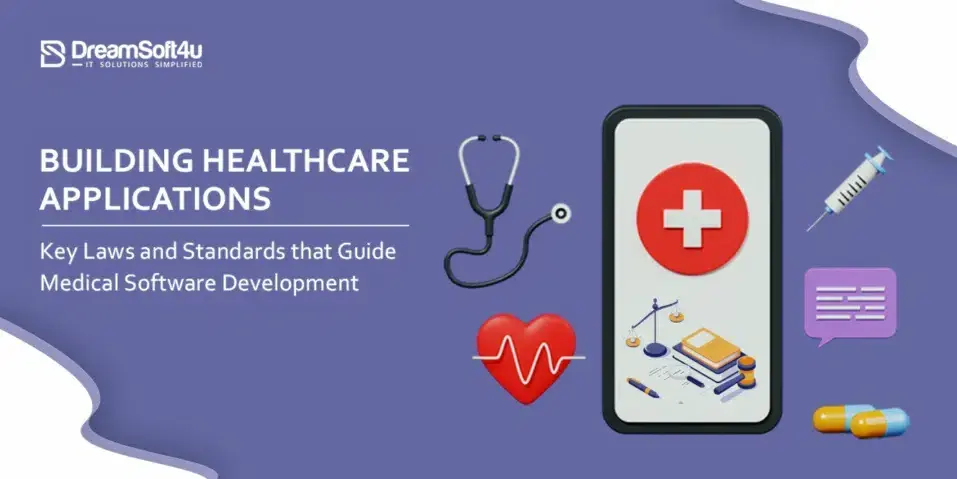Building Healthcare Applications: Key Laws for Medical Software Development
- ds4useodigital
- Jun 21, 2024
- 3 min read
The healthcare industry is going through a digital transformation with advanced technologies in healthcare applications. Every application has a law standard through which they get approved before reaching out to the customer. It impacts patients’ experience by proving the best apps have the potential to change care delivery by improving patient accessibility and convenience. This blog provides a thorough reference of the essential laws and regulations that govern the Laws for Medical Software Development, allowing you to create apps that are both innovative and compliant.
Additionally, Doctors also prefer apps that fulfil all the Laws for Medical Software Development and security standards. However, this fascinating platform comes with a fundamental responsibility: to ensure patient safety and data privacy. To successfully traverse this complex arena, medical software engineers must have a deep understanding of the regulatory context.
The Role of FHIR and HL7 Data Exchange Standards in Building Healthcare Applications
FHIR and HL7 are two of the important standards and regulations guiding the healthcare industry. They establish how health data should be exchanged and shared.
FHIR (Fast Healthcare Interoperability Resources) is the latest standard created by HL7, an international health informatics organization. FHIR makes it easier for healthcare systems and applications to share data by providing a standardized way to format it.
FHIR resources represent granular clinical concepts like patients, practitioners, medications, etc. These resources can be combined to share complex health records.
FHIR uses web standards like JSON and XML, so it’s easy for developers to work with.
FHIR enables seamless data sharing across institutions, platforms, and applications. This helps provide patients with a complete view of their health data.
HL7 refers to a broader set of standards, including FHIR, focused on the exchange, integration, sharing, and retrieval of electronic health information. HL7 standards aim to ensure the meaning, context, and detail of health data transfers are preserved.
By adopting FHIR / HL7 standards, healthcare organizations and technology companies enable more efficient, accurate, and secure data sharing. Patients benefit from improved care coordination and access to their records. Developers gain a framework for building interoperable solutions. And the healthcare system achieves greater productivity, reduced costs, and better outcomes overall.
Implementing Data Standards in Healthcare Applications
To build effective healthcare applications, you need to understand and implement key data standards. These standards enable seamless data sharing across systems and platforms.
Integrating HL7 Standards
The Health Level Seven International (HL7) organization publishes standards for exchanging, integrating, sharing, and retrieving electronic health information. HL7’s Fast Healthcare Interoperability Resources (FHIR) standard defines data elements and an API for exchanging healthcare information electronically.
Integrating FHIR
When approaching Healthcare Software Development Services, integrating the FHIR standard allows you to:
Share patient data between providers, payers, and patients
Enable third-party app integration
Reduce redundant data entry
Improve care coordination and patient outcomes
To use FHIR, you’ll need to:
Choose which FHIR resources, like Patient or Observation, you want to implement based on your app’s needs.
Expose an FHIR API endpoint in your app that allows Create, Read, Update, and Delete (CRUD) operations on resources.
Validate request and response data against the FHIR specification.
Consider security standards like OAuth2 to authorize access to patient data.
Other standards
There are additional standards to consider:
ICD: The International Classification of Diseases defines diagnosis codes.
SNOMED CT: A comprehensive clinical terminology used in EHRs.
LOINC: The Logical Observation Identifiers Names and Codes standard provides universal codes for laboratory and clinical observations.
RxNorm: Normalizes medication names and dose forms across systems.
Implementing data standards in your healthcare applications will make data more portable and interoperable, allowing for improved care and outcomes. Staying up to date with new releases of standards is key to building innovative, patient-centered software.
Conclusion
HIPAA compliance is vitally important for developing healthcare applications. Noncompliance not only carries serious penalties, but it also damages professional reputation. HIPAA compliance requires thorough risk analysis, encryption of personal health data, restricted access, patient data control, extensive training, and breach response strategies. Furthermore, adopting standards such as FHIR, HL7, ICD-10, XDS/XDS-I, and EVV promotes future readiness and interoperability, resulting in smooth data interchange and better care coordination. Partnering with DreamSoft4u, a seasoned healthcare software developer, gives you access to knowledge in compliance, encryption, FHIR, HL7, and new standards, allowing you to create healthcare solutions that are high in quality, innovative, and compliant.
View Original Source: https://www.dreamsoft4u.com/blog/key-laws-for-medical-software-development









Comments